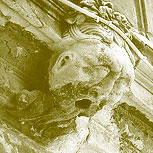
The Eco link in Module 9 of the course readings prompted me to re-read Umberto Eco's The Name of the Rose. If you haven't read it, here's a link to a synopsis.
The first time I read the book, about twenty years ago, I loved it but knew nothing, really, about who Eco was or his work in the field of semiotics. I was interested, in light of the last year of study, to find out how the book would have changed for me since that time.
What struck me powerfully were the ways in which it had not changed for me: I still loved Adso's stubbornly concrete view of the world, and William's rational but compassionate lens. I still felt completely drawn in to the physical world of the Abbey and the shadowy half-world of the library. I still loved the murder mystery itself, having completely forgotten the solution to the riddle of the murders (I have a convenient sort of fictional forgetfulness that allows me to read books over and over and still be surprised).
When I first read the novel, I had not really thought of the way in which the culture of a time, a place, and a language dominates the thinking of the people in it. For this reason, the setting and characters in the novel seemed almost science-fictional at the time. I accepted this other world as I would accept a settlement on Mars and colonists long since exiled from the world I know.
This second reading was, in a way, a more anthropological one. I was listening to the language of the characters - associating it with the philosophy of the medieval scholastics and the doctrines of the Catholic Church at the time. I understood a lot better how intensely dangerous ideas that fell outside the bounds of accepted thought could be. The hesitations of the denizens of the Abbey and of both William and Adso ceased to be fantastical. And they led me to question how, now, we have different "heretical" thoughts that we also hide and disguise within fiction. Specifically, it led me to re-examine my reading of William Gibson's Pattern Recognition, with its logo-adverse heroine who is both a specialist and deeply allergic to corporate branding (for a fuller, more proficient synopsis, click here). Still, Eco himself would have it that my first reading isn't actually an erroneous one, if we accept his view that novels are "machines for making possible worlds" (Eriksson).
What also struck me were the ways in which I saw the book in a new light, and what deep admiration it engendered in me for anyone who researches their work so beautifully, so obsessively, as to populate an entire novel with meticulous clues to the origins of his ideas. This is something I probably did not see on first reading. Being a passive and greedy reader, I just let the thousands of references flutter down around me like confetti. But now, reading it again, I can see the mind that created this semiotic treasure-trove behind the story; that he is literally illustrating in fictional form the mnemonic arts ascribed to the monks at the Abbey (Newlon).
Many critics have, as Birgit Eriksson remarks, have read the novel "as being just a fictionalised version of his theoretical work". But I find it impossible to read this way because, as Eriksson points out, it not only illustrates his theory, it shows the limits of it. And it this way, it gave me a lot of insight into what relationship my own fictional writing and critical theory might have.
Although I'm not a theorist, I have been deeply impacted by many of the theories I've read about. I don't think it's possible to get through this degree and not, somehow, reflect that learning in my fictional work. However, I've been very concerned about how it might be affecting it, worried that it would warp my writing into something inauthentic and somehow "posed" for framing by one theory or another.
What is brilliant and inspirational to be about The Name of the Rose, is that it underscores the fact that, no matter how far theory can take us, it is a machine for describing worlds, not creating them.
References:
Eco, Umberto. The Name of the Rose. New York: Harcourt, Inc., 1980.
Eriksson, Birgit. A Novel Look at Theory: About Umberto Eco's The Name of the Rose and Foucault's Pendulum. Centre for Cultural Research, University of Aarhus. 01 May 2000. 2 May 2008 http://www.hum.au.dk/ckulturf/pages/publications/be/novel.htm.
Gibson, William. Pattern Recognition. Paperback. New York: Berkley, 2005.
Newlon, Brendan. Beasts and Buildings: Religious Symbolism and Medieval Memory. The Modern Word. nd. 1 May 2008 http://www.themodernword.com/eco/eco_paper_newlon.pdf.
770 words (4,850 and counting)
Revisiting the Rose
Thursday, May 1, 2008Posted by Madeleine Morris at 2:22 AM
Subscribe to:
Post Comments (Atom)

0 comments:
Post a Comment